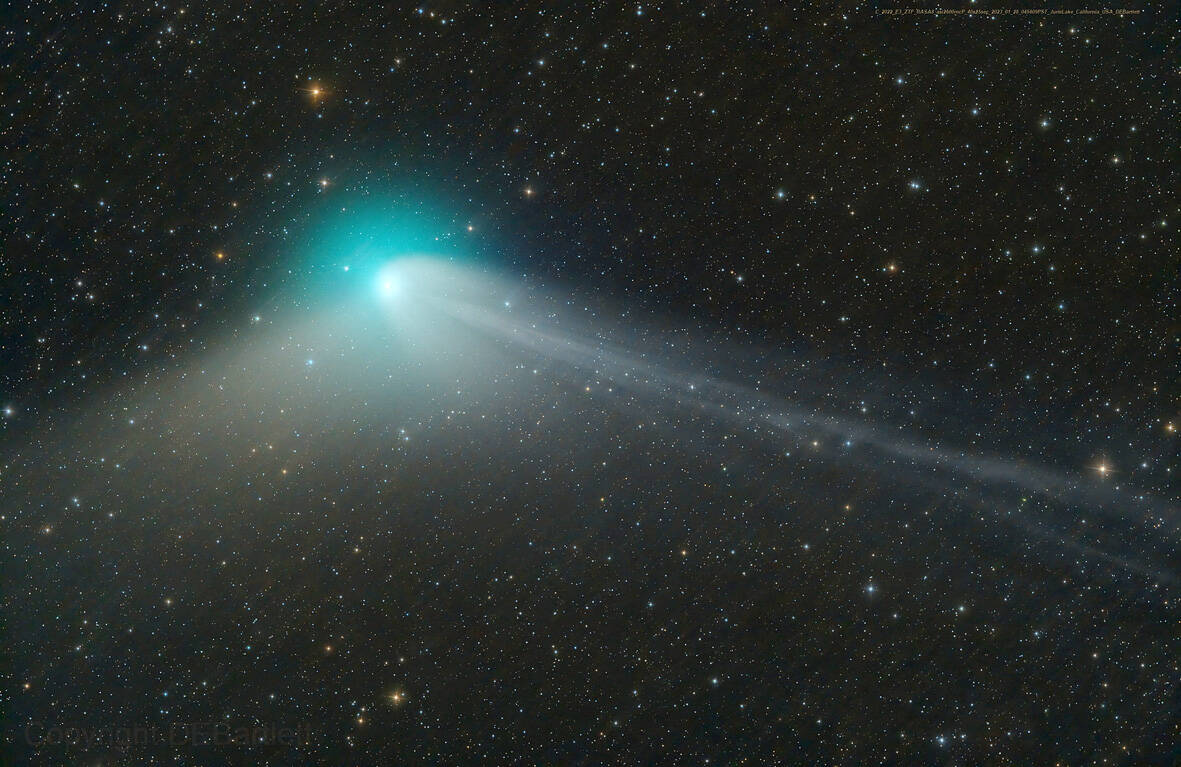A green-hued comet that has been lurking in the night sky for months is expected to be the most visible to stargazers this week as it gradually passes Earth for the first time in about 50,000 years.
The cosmic visitor will swing by our planet at a distance of about 42.5 million kilometers.
Here is an explanation of comets in general and this one in particular.

Photo: Reuters
WHAT IS A COMET?
Nicknamed “dirty snowballs” by astronomers, comets are balls of ice, dust and rocks that typically hail from the ring of icy material called the Oort cloud at our solar system’s outer edge. One known comet actually originated outside the solar system — 2I/Borisov.
Comets are composed of a solid core of rock, ice and dust and are blanketed by a thin and gassy atmosphere of more ice and dust, called a coma. They melt as they approach the sun, releasing a stream of gas and dust blown from their surface by solar radiation and plasma and forming a cloudy and outward-facing tail.
Comets wander toward the inner solar system when various gravitational forces dislodge them from the Oort cloud, becoming more visible as they venture closer to the heat given off by the sun. Fewer than a dozen comets are discovered each year by observatories around the world.
This comet last passed Earth at a time when Neanderthals still inhabited Eurasia, our species was expanding its reach beyond Africa, big Ice Age mammals including mammoths and saber-toothed cats roamed the landscape and northern Africa was a wet, fertile and rainy place.
The comet can provide clues about the primordial solar system because it formed during the solar system’s early stages, according to California Institute of Technology physics professor Thomas Prince.
WHY IS THE COMET GREEN?
The green comet, whose formal name is C/2022 E3 (ZTF), was discovered on March 2 last year by astronomers using the Zwicky Transient Facility telescope at Caltech’s Palomar Observatory in San Diego. Its greenish, emerald hue reflects the comet’s chemical composition — it is the result of a clash between sunlight and carbon-based molecules in the comet’s coma.
NASA plans to observe the comet with its James Webb Space Telescope (JWST), which could provide clues about the solar system’s formation.
“We’re going to be looking for the fingerprints of given molecules that we can’t access from the ground,” said planetary scientist Stefanie Milam of NASA’s Goddard Space Flight Center in Maryland. “Because JWST’s so sensitive, we’re expecting new discoveries.”
HOW CAN I SEE THE GREEN COMET?
Using binoculars during a clear night, the comet can be seen in the northern sky. On Monday, it appeared between the Big Dipper and Polaris, the North Star. And today, it was positioned to appear near the constellation Camelopardalis, bordered by Ursa Major, the Big Dipper and the Little Dipper.
Finding a remote location to avoid light pollution in populated areas is key to catching a nice view of the comet as it journeys past our planet heading away from the sun and back toward the solar system’s outer reaches.

Behind a car repair business on a nondescript Thai street are the cherished pets of a rising TikTok animal influencer: two lions and a 200-kilogram lion-tiger hybrid called “Big George.” Lion ownership is legal in Thailand, and Tharnuwarht Plengkemratch is an enthusiastic advocate, posting updates on his feline companions to nearly three million followers. “They’re playful and affectionate, just like dogs or cats,” he said from inside their cage complex at his home in the northern city of Chiang Mai. Thailand’s captive lion population has exploded in recent years, with nearly 500 registered in zoos, breeding farms, petting cafes and homes. Experts warn the

The unexpected collapse of the recall campaigns is being viewed through many lenses, most of them skewed and self-absorbed. The international media unsurprisingly focuses on what they perceive as the message that Taiwanese voters were sending in the failure of the mass recall, especially to China, the US and to friendly Western nations. This made some sense prior to early last month. One of the main arguments used by recall campaigners for recalling Chinese Nationalist Party (KMT) lawmakers was that they were too pro-China, and by extension not to be trusted with defending the nation. Also by extension, that argument could be

Aug. 4 to Aug. 10 When Coca-Cola finally pushed its way into Taiwan’s market in 1968, it allegedly vowed to wipe out its major domestic rival Hey Song within five years. But Hey Song, which began as a manual operation in a family cow shed in 1925, had proven its resilience, surviving numerous setbacks — including the loss of autonomy and nearly all its assets due to the Japanese colonial government’s wartime economic policy. By the 1960s, Hey Song had risen to the top of Taiwan’s beverage industry. This success was driven not only by president Chang Wen-chi’s

Last week, on the heels of the recall election that turned out so badly for Taiwan, came the news that US President Donald Trump had blocked the transit of President William Lai (賴清德) through the US on his way to Latin America. A few days later the international media reported that in June a scheduled visit by Minister of National Defense Wellington Koo (顧立雄) for high level meetings was canceled by the US after China’s President Xi Jinping (習近平) asked Trump to curb US engagement with Taiwan during a June phone call. The cancellation of Lai’s transit was a gaudy